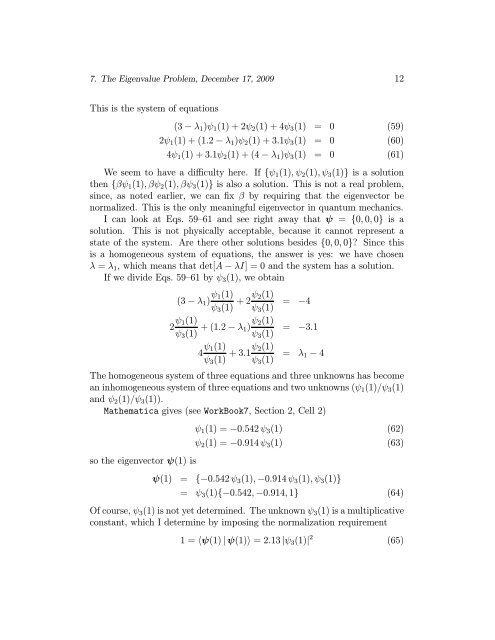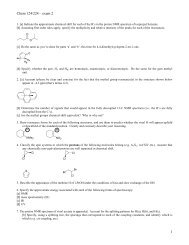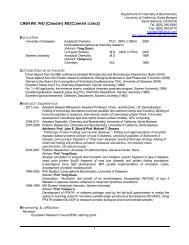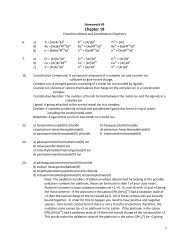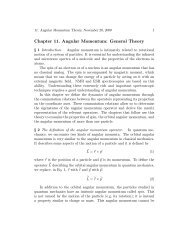Chapter 7. The Eigenvalue Problem
Chapter 7. The Eigenvalue Problem
Chapter 7. The Eigenvalue Problem
Create successful ePaper yourself
Turn your PDF publications into a flip-book with our unique Google optimized e-Paper software.
<strong>7.</strong> <strong>The</strong> <strong>Eigenvalue</strong> <strong>Problem</strong>, December 17, 2009 12<br />
This is the system of equations<br />
(3 − λ 1 )ψ 1 (1) + 2ψ 2 (1) + 4ψ 3 (1) = 0 (59)<br />
2ψ 1 (1) + (1.2 − λ 1 )ψ 2 (1) + 3.1ψ 3 (1) = 0 (60)<br />
4ψ 1 (1) + 3.1ψ 2 (1) + (4 − λ 1 )ψ 3 (1) = 0 (61)<br />
We seem to have a difficulty here. If {ψ 1 (1), ψ 2 (1), ψ 3 (1)} is a solution<br />
then {βψ 1 (1), βψ 2 (1), βψ 3 (1)} is also a solution. This is not a real problem,<br />
since, as noted earlier, we can fix β by requiring that the eigenvector be<br />
normalized. This is the only meaningful eigenvector in quantum mechanics.<br />
I can look at Eqs. 59—61 and see right away that ψ = {0, 0, 0} is a<br />
solution. This is not physically acceptable, because it cannot represent a<br />
state of the system. Are there other solutions besides {0, 0, 0} Since this<br />
is a homogeneous system of equations, the answer is yes: we have chosen<br />
λ = λ 1 , which means that det[A − λI] = 0 and the system has a solution.<br />
If we divide Eqs. 59—61 by ψ 3 (1), we obtain<br />
(3 − λ 1 ) ψ 1(1)<br />
ψ 3 (1) +2ψ 2(1)<br />
= −4<br />
ψ 3 (1)<br />
2 ψ 1(1)<br />
ψ 3 (1) +(1.2 − λ 1) ψ 2(1)<br />
= −3.1<br />
ψ 3 (1)<br />
4 ψ 1(1)<br />
ψ 3 (1) +3.1ψ 2(1)<br />
= λ 1 − 4<br />
ψ 3 (1)<br />
<strong>The</strong> homogeneous system of three equations and three unknowns has become<br />
an inhomogeneous system of three equations and two unknowns (ψ 1 (1)/ψ 3 (1)<br />
and ψ 2 (1)/ψ 3 (1)).<br />
Mathematica gives (see WorkBook7, Section 2, Cell 2)<br />
so the eigenvector ψ(1) is<br />
ψ 1 (1) = −0.542 ψ 3 (1) (62)<br />
ψ 2 (1) = −0.914 ψ 3 (1) (63)<br />
ψ(1) = {−0.542 ψ 3 (1), −0.914 ψ 3 (1), ψ 3 (1)}<br />
= ψ 3 (1){−0.542, −0.914, 1} (64)<br />
Of course, ψ 3 (1) is not yet determined. <strong>The</strong> unknown ψ 3 (1) is a multiplicative<br />
constant, which I determine by imposing the normalization requirement<br />
1=ψ(1) | ψ(1) =2.13 |ψ 3 (1)| 2 (65)


